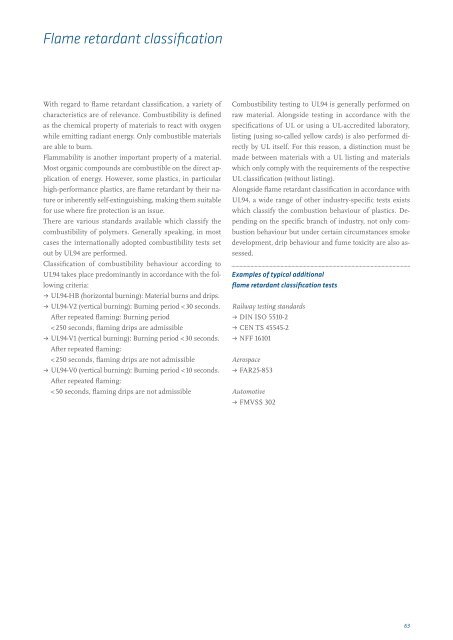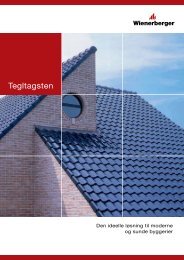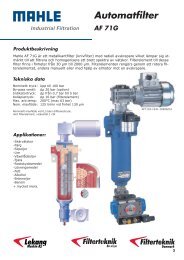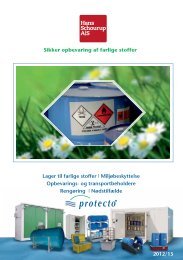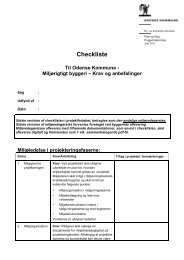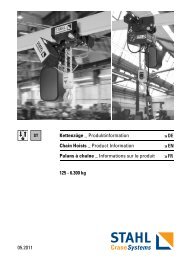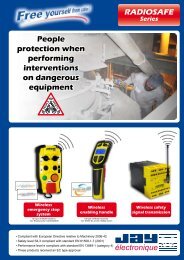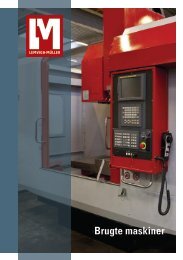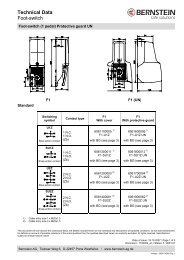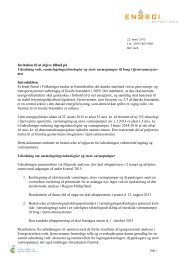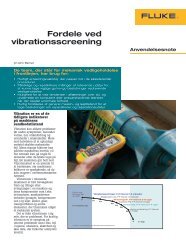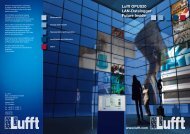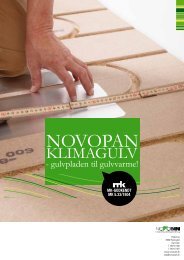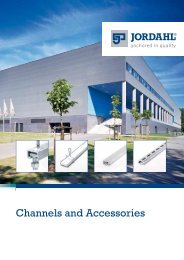Engineering plastics â The Manual - F.wood-supply.dk
Engineering plastics â The Manual - F.wood-supply.dk
Engineering plastics â The Manual - F.wood-supply.dk
You also want an ePaper? Increase the reach of your titles
YUMPU automatically turns print PDFs into web optimized ePapers that Google loves.
Flame retardant classification<br />
With regard to flame retardant classification, a variety of<br />
characteristics are of relevance. Combustibility is defined<br />
as the chemical property of materials to react with oxygen<br />
while emitting radiant energy. Only combustible materials<br />
are able to burn.<br />
Flammability is another important property of a material.<br />
Most organic compounds are combustible on the direct application<br />
of energy. However, some <strong>plastics</strong>, in particular<br />
high-performance <strong>plastics</strong>, are flame retardant by their nature<br />
or inherently self-extinguishing, making them suitable<br />
for use where fire protection is an issue.<br />
<strong>The</strong>re are various standards available which classify the<br />
combustibility of polymers. Generally speaking, in most<br />
cases the internationally adopted combustibility tests set<br />
out by UL94 are performed.<br />
Classification of combustibility behaviour according to<br />
UL94 takes place predominantly in accordance with the following<br />
criteria:<br />
ˌˌUL94-HB (horizontal burning): Material burns and drips.<br />
ˌˌUL94-V2 (vertical burning): Burning period < 30 seconds.<br />
After repeated flaming: Burning period<br />
< 250 seconds, flaming drips are admissible<br />
ˌˌUL94-V1 (vertical burning): Burning period < 30 seconds.<br />
After repeated flaming:<br />
< 250 seconds, flaming drips are not admissible<br />
ˌˌUL94-V0 (vertical burning): Burning period < 10 seconds.<br />
After repeated flaming:<br />
< 50 seconds, flaming drips are not admissible<br />
Combustibility testing to UL94 is generally performed on<br />
raw material. Alongside testing in accordance with the<br />
specifications of UL or using a UL-accredited laboratory,<br />
listing (using so-called yellow cards) is also performed directly<br />
by UL itself. For this reason, a distinction must be<br />
made between materials with a UL listing and materials<br />
which only comply with the requirements of the respective<br />
UL classification (without listing).<br />
Alongside flame retardant classification in accordance with<br />
UL94, a wide range of other industry-specific tests exists<br />
which classify the combustion behaviour of <strong>plastics</strong>. Depending<br />
on the specific branch of industry, not only combustion<br />
behaviour but under certain circumstances smoke<br />
development, drip behaviour and fume toxicity are also assessed.<br />
Examples of typical additional<br />
flame retardant classification tests<br />
Railway testing standards<br />
ˌˌDIN ISO 5510-2<br />
ˌˌCEN TS 45545-2<br />
ˌˌNFF 16101<br />
Aerospace<br />
ˌˌFAR25-853<br />
Automotive<br />
ˌˌFMVSS 302<br />
63


